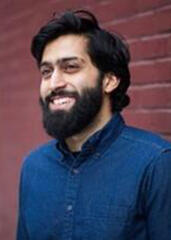The benefits
At its core, community-based filmmaking is an art form that relies on building trusting relationships, which is difficult to do in a single semester and requires students to take risks. But Syeed urges students to narrow their projects to a manageable scope and illustrates how powerful a mosaic of smaller-scale stories can be. By encouraging them to experiment – both with the technical elements of filmmaking and the creative elements of storytelling and community engagement – students are pushed to challenge their limits. They learn through creating, navigating pressing issues of authorship, reciprocity, and accountability in a hands-on, productive way.
“Students come in feeling uncertain about what stories they can tell and how to best tell them. Having space to experiment—and to fail—is important.”
The challenges
Syeed notes that many students have questions about responsibility in storytelling and what stories they should tell given their respective identities, but issues of ethics and engagement are rarely integrated in film school curricula. By focusing on a community-based model of filmmaking, where students co-create with their participants, Syeed’s course demonstrates how mindful engagement and relationship-building can bolster filmmaking craft, leading to better art. In addition, since many students are first-time filmmakers who might be less familiar with the technical requirements of filmmaking, Syeed has worked with the Lamont Media Lab and the Bok Center to complement the training students receive in class.
Takeaways and best practices
-
Provide safe space to experiment. Syeed finds that students are often hesitant to embark on creative projects and that being community-minded leads them to be cautious. To overcome this, Syeed implements a series of low-stakes assignments and spaces for students to workshop their concerns before committing to a final project. The course also introduces a wide spectrum of co-creation models through screenings, readings, and discussions with working filmmakers, so students can be empowered to formulate their own approach to engaging their specific community participants.
-
Build in self-assessment. Creative work lends itself well to self-reflection. In addition to having students write field reports where they reflect on their challenges in the field, Syeed starts each class with a meditation practice to set a tone of mindful self-inquiry.
-
End on a high note. This course ends with a miniature film festival and awards show where students screen their current cuts of their documentaries. While the films are rarely in final form, the event allows students to celebrate their experiments, successes, and challenges.
Bottom line
Students are eager to engage in creative work in their courses, but are hesitant to take risks that place them outside their comfort zone. As instructors, you can provide space and tools for students to experiment with their research interests and support their development as they explore new ideas.
 Musa Syeed, Briggs Copeland Lecturer on English, teaches screenwriting in the Creative Writing Program. Students are introduced to documentary and hybrid filmmaking in his course, Get Real: The Art of Community-Based Film. While learning about the technical and ethical considerations of creating a short narrative film or documentary, they also are challenged to effectively engage with their community in an intentional, responsible way that addresses issues of authorship and social impact. The Mindich Program in Engaged Scholarship helps with curriculum design and also funding support (for example, providing gift cards for community participants or funding a TA).
Musa Syeed, Briggs Copeland Lecturer on English, teaches screenwriting in the Creative Writing Program. Students are introduced to documentary and hybrid filmmaking in his course, Get Real: The Art of Community-Based Film. While learning about the technical and ethical considerations of creating a short narrative film or documentary, they also are challenged to effectively engage with their community in an intentional, responsible way that addresses issues of authorship and social impact. The Mindich Program in Engaged Scholarship helps with curriculum design and also funding support (for example, providing gift cards for community participants or funding a TA).
